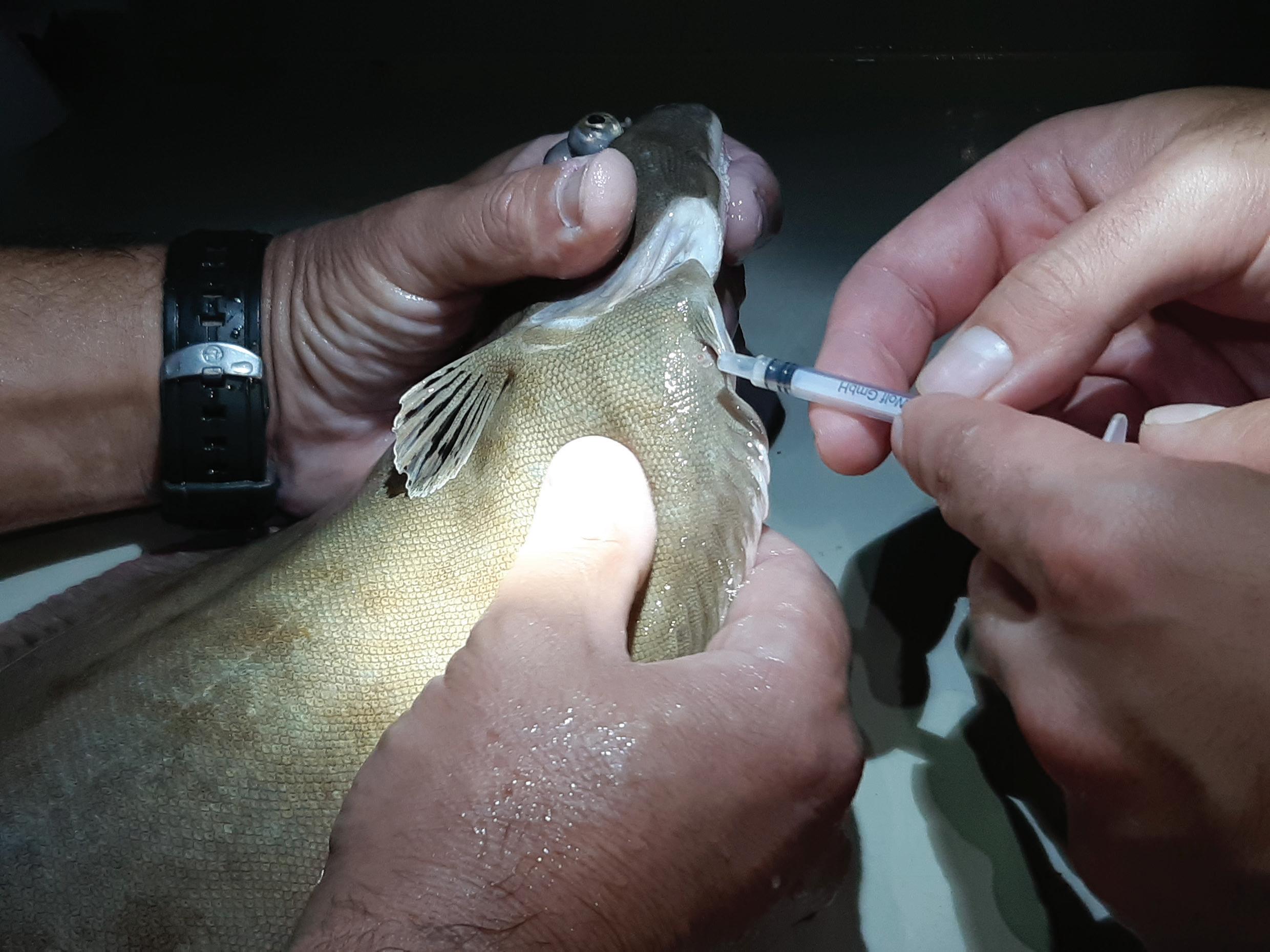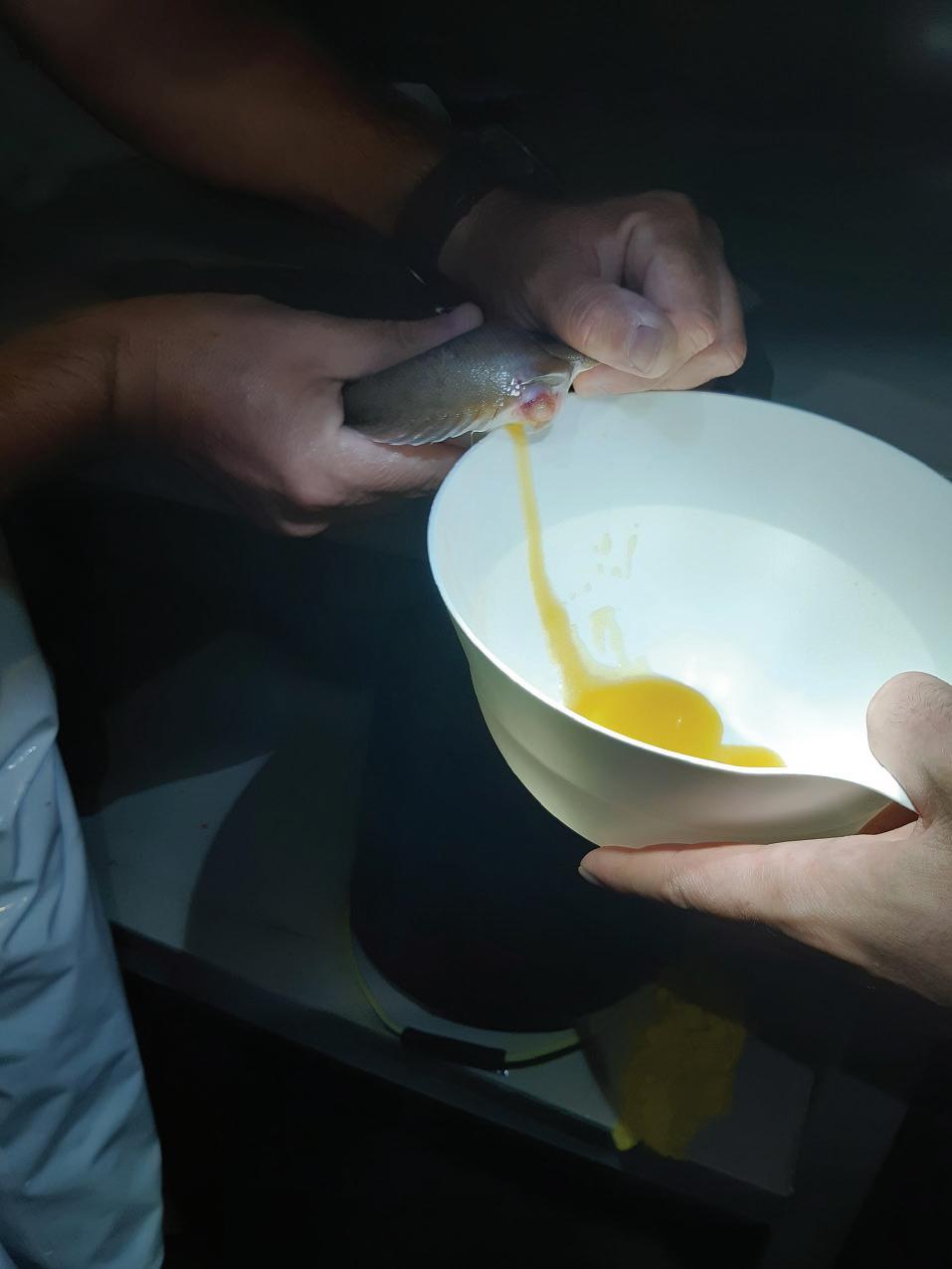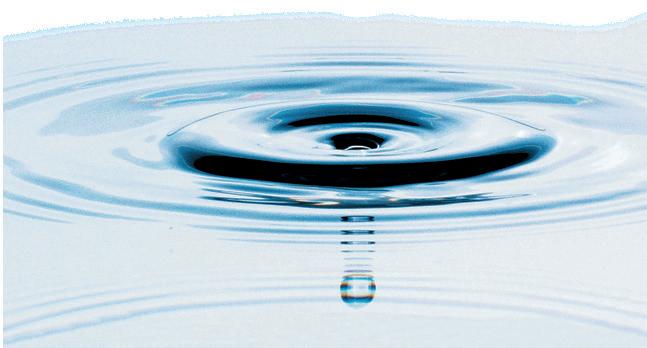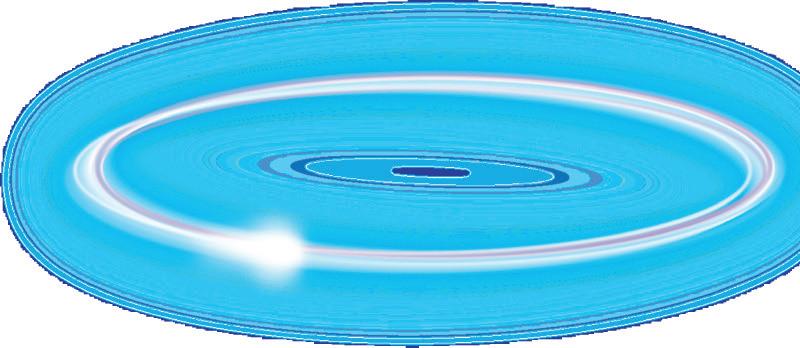
11 minute read
Biotechnology opens the door for sustainable sole aquaculture
Isidro Blanquet, Carlos Vilafranca, Diogo Rosado, Micaela Martins and Frederico Silva, Safiestela Ltd., Ignacio Giménez, RARA AVIS BIOTEC SL, Joan Cerdà, Neil Duncan, François Chauvigné, Wendy González-López and Sandra Ramos-Júdez, IRTA
Stripping Senegalese sole sperm for in vitro fertilization at Safiestela Ltd.
The project REARLING, funded by the Portugal 2020 program, Compete 2020, and the European Union through FEDER/ERDF, has established the sustainable aquaculture production of Senegalese sole through the implementation of biotechnologies that removed the bottleneck in the species reproductive control to close the biological cycle in captivity.
The project brought together Safiestela Ltd., IRTA and RARA AVIS BIOTEC SL to finetune and adjust technologies for the control of sole reproduction. Until recently, the production of Senegalese sole juveniles relied on the capture of wild broodstocks from unsustainable fisheries as large-scale egg production from hatchery-produced breeders had failed, either through attempts to obtain natural spontaneous spawning or through in vitro fertilization. The principal problem that is frustrating the implementation of in vitro fertilization is the low quantities of poor-quality sperm, which is usually collected from sole males.
8.00
7.00
6.00
Larvae (millions) 5.00
4.00
3.00 • Passou de 56% 2019 para 75% em 2020. • Falta de sincronização dos selvagens.
In vitro fertilization In vitro fertilization
2.00
1.00
Natural spawning
0.00
2019
Figure 1. Larval production from in vitro fertilization and natural spawning. Safiestela Ltd.
Natural spawning
2020
Producing high-quality sperm
To increase the production of sperm in Senegalese sole, researchers from the project tested the use of artificial hormones which mimic the natural hormones that typically control the growth and maturation of the gonad, called gonadotropins. These hormones, follicle-stimulating and luteinizing hormones (FSH and LH, respectively), were produced by the company RARA AVIS BIOTEC SL by inserting recombinant DNA molecules encoding modified Senegalese sole FSH and LH into cultured mammalian cells, which act as a factory to produce high amounts of the hormones. Using this approach, research showed that sequential treatment of males with recombinant FSH and LH through intramuscular injection was effective at increasing the circulating levels of androgens in the blood, and was able to increase by approximately 10-fold the production of good quality sperm. Importantly, these studies also demonstrated that the recombinant hormones are completely degraded after two weeks of injection into the fish, thus assuring that these compounds do not enter into the food chain through the offspring.
In vitro fertilization
In addition to increasing sperm production, the project implemented in vitro fertilization protocols, which defined how to manage sperm and eggs to obtain good levels of fertilization and production of larvae to stock larval growing facilities.
Sperm was collected into and stored in commercial extender solutions (Marine Freeze® IMF technologies or modified Leibovitz) that improved the quality of the sperm and increased the storage time during which the sperm quality was maintained. This enabled the sperm to be cold stored (4°C) until eggs were obtained from ovulated females. In addition, the sperm of the highest quality can be cryopreserved for longer-term storage.
To manage the eggs, both the timing of ovulation and the period post-ovulation, during which the eggs are still viable, were defined under the hatchery conditions. Females were induced to ovulate with gonadotropin releasing hormone analogues (GnRHa) and the time from hormone application to ovulation was determined. Once ovulated, the eggs must be fertilized as soon as possible after collection as it appears that from ovulation onwards the eggs gradually lose viability. Lastly, the amount of sperm required to obtain a high percentage of fertilization of a batch of eggs was tested and determined to ensure single, male + female crosses were possible to fertilize large egg batches to stock the hatchery infrastructure.
Therefore, the in vitro process was defined as a manageable sequence where females and males were selected, sperm from gonadotropin induced males was collected and stored just before the expected ovulation
Stripping Senegalese sole eggs for in vitro fertilization at Safiestela Ltd.

and the good quality gametes were mixed at the correct moment. The process appears complex and labor intensive, but 2-3 females are easily managed to stock the entire hatchery or more fish can be used if a greater genetic variation is required.


Conclusions
Taken together, the project has implemented successful methods for enhanced sperm production and in vitro fertilization protocols in the Senegalese sole. This has given the hatchery Safiestela Ltd. full control to choose when fertilized eggs are produced and removed the reliance on natural and sometimes unpredictable spawns from wild broodstocks. During the project, the hatchery has changed from completely relying on naturally spawning wild broodstocks to obtaining a majority of eggs from in vitro fertilization in 2020 (Fig. 1). In addition, the hatchery staff can now choose which breeders are used for crosses to produce juveniles from breeders with desired production characteristics such as fast growth, fish shape or meat quality.
This is the first step towards the implementation of breeding programs for Senegalese sole that will improve the farms’ production for many generations.
More information: Isidro Blanquet
R&D Manager SEA8 Group, Portugal E: isidroblanquet@sea8.eu

Regional developments
Gidon Minkoff
Gidon Minkoff operates consulting services for the hatchery sector at Fish Hatchery Consulting. E: gminkoff@gmail.com
Intensification and diversification in European marine fish hatcheries

The European marine fish hatchery sector is a mature industry with over 35 years of building up expertise in the mass production and supply of juvenile fishes to the farms. It has evolved while contending with the roller coaster ride of changing markets, global recessions as well as with an ever changing environmental, social and legislative landscape. Despite these upheavals (such as the current COVID pandemic), it has supplied farms with the fish they require and has continuously developed production methods and logistic strategies that have increased both quantity and quality while reducing production costs.
The bulk of production in the EU comes from the bream and bass hatcheries. Annually 750-850 million fish are produced and moved to sea cages once they attain a size of 5-10 grams. The ratio of the output of these two species can change, and often does, on a yearly basis depending on the market trends and the requirements of the farms. EU hatcheries are also producing turbot (7-10 million fish/year) as well as the upcoming new species such as sole (4 million fish), meagre (6-8 million) and smaller quantities of yellowtail (S. lalandi and S. dumerilli).
The quantity of bream/bass produced in the EU plateaued around 2015. From that point on, increasing numbers of fish from the EU (as well as Turkey) have been supplied to fish farms in the Middle East and North Africa. Expanding into these geographical areas presents an opportunity for European companies that are supplying fish, expertise and the hatchery technology that has been accumulated over 30 years of operating and managing such complex systems. This combined activity is driving a consistent and substantial increase in global bream/bass production. Gradual but constant improvements in production methods have increased the output per hatchery from a few million fish per year to the current average of 20-40 million fish per year per hatchery. In the process of intensification, the survival of bream and bass from egg to juvenile has increased from around 10% to 30-50%. This higher productivity has resulted in a reduction of the COP which currently is situated at €0.10-0.15 per juvenile (sale price of juveniles to third parties is between €0.18-0.22 /juvenile).
There is a significant difference between the hatcheries of southern and northern Europe. In southern Europe, only a handful of hatcheries are producing in the range of 1-3 million fish per year with most smaller hatcheries specializing in alternative species such as turbot, sole, meagre and yellowtail. In the north, most of the production is aimed at producing cleaner fish for the salmon farms. These hatcheries produce in the range of 1-3 million fish per year.
Northern Europe has seen a significant drive in producing cleaner fish and a renewed impetus in producing Atlantic cod and halibut. With respect to cleaner-fish production, Mr. Richard Pricket who operates and manages Dorset Cleaner fish Ltd., has generously provided the following details.
Two species are being produced in hatcheries, ballan wrasse (Labrus bergylta) and lumpfish (Cyclopterus lumpus) with main production centers in Norway, the UK, Ireland and Iceland. In general, Norway applies open systems and the UK and Ireland apply recirculation systems. Norway is the main producer, and in 2019 there were 26 companies with a total production of 39 million lumpfish and 680,000 wrasse, while total UK, Ireland and Scotland production stand at 8 million lumpfish and 1 million ballan wrasse.
Ballan wrasse are technically much more difficult than lumpfish and require live feed during the larval stages and specialized weaning diets. Growth is also very slow and deformities quite high. It takes about 18 months to produce a 40-60 g fish ready for deployment. Wrasse are used mainly when sea temperatures are >12°C. Lumpfish are the opposite, being able to take dried feed at post-yolk-sac stage and growing to deployment size of 25 g in 6-9 months. Lumpfish are the preferred cleaner fish in the cold winter months.
Moving tens of millions of bream and bass from hatchery to farm during the warmer months of the year necessitates highly coordinated logistics amongst the different production departments. This very intense activity requires that each sector of the production chain, broodstock, live food, larvae, nursery and transport, perform in concert at optimal output over 10-11 months of the year. To achieve this, the technical teams of the hatcheries, with the additional input from veterinarians, feed and equipment suppliers as well as academics, have constantly been improving production methodology and reliability.
For successful larval rearing green water, rotifers and Artemia were always and are still, essential. There is, however, a constant sophistication of the process through incorporating into the diets the most up-to-date nutritional formula. Rotifer mass cultures currently employ “all-in-one” diets that are both beneficial for rotifer reproduction as well as providing the required nutrition to the fish larvae. Artemia cysts are better selected for hatching rates as well as being magnetized for removing un-hatched cysts and shells. These improvements simplify the process, reducing the manipulation time of live feed and the losses of live feed that occur through consecutive rinsing and cleaning before being introduced into the larval rearing tanks.
Feed companies have also been at the forefront of adapting the diets, whether for live food, weaning or nursery, to the latest nutritional knowledge as generated by the scientific community. More recently, EU hatcheries are opting for and exploring the use of algae pastes, freeze-dried algae and algae substitutes for green water and rotifer feeds. The objective here is to eliminate the costly and precarious in-house algae production systems and replace them with off-theshelf products of consistent quality. The availability of dried or pasted algae has also contributed to developing high-density rotifer culture systems through the adoption of flow-through and recirculation technologies. These improvements have allowed hatcheries to increase the productivity of live food by an order of magnitude while keeping constant the footprint, manpower and energy costs that drive the system.
Prior to leaving the larval rearing section, larvae are weaned into dry diets and then moved to the nursery. At this stage, fish are graded to reduce cannibalism and create homogenous size groups. Feeding is mainly automated and fish are moved around with fish pumps and in many cases, they are machine-graded and counted. Nurseries are either flow-through or RAS. Those hatcheries that have an abundant supply of seawater from boreholes tend to use flow-through systems. RAS technology is becoming more and more common in hatcheries that use pumped ashore water as it enables them to intensify production without having to re-engineer the seawater pumping and filtration systems.
The greatest asset of the hatcheries is the technicians and operators that work these facilities. In Southern Europe, workforce mobility is limited and the population that wants to stay or move to rural community values obtaining and retaining a fixed yearround position such as those offered by the hatcheries. For this reason, many of the hatcheries have employees that have worked on the production for 20 years or more and have accumulated experience and expertise that is invaluable to the success of these companies.
Looking ahead, improvements are on their way through automation as well as the genetic selection for faster-growing fish. Currently, the grow-out period on the farm for either bream or bass is 14 months or more, so accelerating growth through genetic selection will have a significant impact on the bottom line. Collaborations between the private and public sectors in Europe are now working towards this goal. Diversification into faster-growing species, such as meagre and yellowtail, will also lend itself to increasing the yield from the farms as these fish can grow to 1 kg or more in their first year at sea. All in all, the current technological level of the European hatcheries provides a solid foundation that is much needed for increasing production volume as well as diversifying into new and alternate species.










